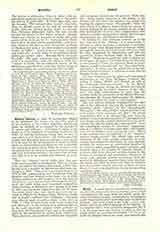

Monita Secreta , a code of instructions alleged to be addressed by Acquaviva, the fifth general of the Society, to its various superiors, and laying down the methods to be adopted for the increase of its power and influence. According to them, every means is to be employed of acquiring wealth for the order, by enticing promising young men to enter it and endow it with their estates; rich widows are to be cajoled and dissuaded from remarriage; every means is to be used for the advancement of Jesuits to bishoprics or other ecclesiastical dignities, and to discredit the members of other orders, while the world is to be persuaded that the Society is animated by the purest and least interested motives: the reputation of those who quit it is to be assailed and traduced in every way.
That the “Monita” are in reality what they pretend, cannot possibly be maintained. They are known to be the work of one Jerome Zahorowski, a Pole, who, having been a member of the Society, had been discharged in 1611. They first appeared at Cracow in 1612 in MS., purporting to be a translation from the Spanish, and were printed in the same city in 1614. Various stories were told, however, as to the mode in which these secret instructions were originally discovered; the credit being most commonly assigned to Duke Christian of Brunswick who, having been born in 1599, was a mere boy when they first saw the light. The place where they were found was variously set down as Paderborn, Prague, Liege, Antwerp, Glatz, and on board a captured East Indiaman. Attempts were likewise made at various times, as late even as 1783, to excite interest in the work as the result of a new discovery; to say nothing of an undated edition, in the early nineteenth century, which professes to issue from the Propaganda Press, and to be authenticated by the testimonies of various Jesuit authorities. These, however, are manifestly nothing but impudent and malignant fabrications, the general, “Felix Aconiti”, being utterly unknown in the Annals of the Society, and the censor who approves the publication bearing the ominous name “Pasquinelli”, while the titles which, it is alleged, should ensure the esteem of men in general for the Society, include all the crimes and abominations of every kind—immoralities, conspiracies, murders, and regicides—which their bitterest enemies have ever attributed to the Society.
In looking for more authentic evidence as to the true character of the “Monita”, it is unnecessary to cite any to whose testimony a suspicion of partiality might attach—from Bishop Lipski of Cracow (1616), through the long list of Jesuit writers who have from the first denounced the fabrication, and who are quoted by Father Bernard Duhr in his “Jesuiten Fabeln”. Witnesses beyond any such exception are for example, the famous Fra Paolo Sarpi, the historian of the Council of Trent, the Jansenist Henri de Saint-Ignace, as well as Arnauld and the “Nouvelles Ecclesiastiques”, to whom may be added Pascal himself, whose negative testimony is sufficient to show what he thought on the subject.
To these witnesses may be added such pronounced anti-Jesuits as von Lang, Dollinger, Friedrich (the author of Janus), Huber, and Reusch, as well as the Protestant historian Gieseler. In the British House of Commons, during the debates on Catholic Emancipation, the fraudulent character of the “Monita” was fully acknowledged by more than one speaker, while the authorities of the British Museum, and likewise the French bibliographer M. Barbier, agree in describing the work as “apocryphal”.
The only defense seriously attempted on the other side is that offered by the late Dr. Littledale in his notorious article “Jesuits”, in the “Encyclopaedia Britannica”. He acknowledges, indeed, that the work is in reality “both caricature and libel”, but pleads nevertheless that it is substantially true, since its author, “a shrewd and keen observer”, having noticed how Jesuits actually worked, deduced from his observations the rules by which they were guided. As to this remarkable example of “jesuitical” argumentation, it is sufficient to inquire upon what solid foundation Dr. Littledale’s basal assumption rests. Where is the evidence that the principles of the “Monita” animate Jesuit practice? The official rules and constitutions of the order plainly contradict in every respect these supposed instructions, for they expressly prohibit the acceptance of ecclesiastical dignities by its subjects, unless compelled by papal authority, and from the days of the founder, St. Ignatius himself, it is known that every obstacle has been thrown by the Society in the way of such promotion. Moreover, in many cases, genuine private instructions from the general to subordinate superiors have fallen into hostile hands, but while in many cases they are found to give instructions directly contrary to’those we have heard, it is not even alleged that in any instance they corroborate them.
JOHN GERARD

